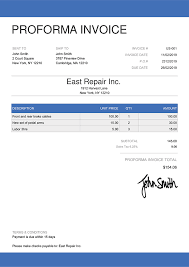As an invoice form is not required for accounting purposes, you and the client cannot use the proforma. There is no money involved here. Rather, proforma invoices are typically used as an invoice in the process of obtaining prices or to aid in customs import calculations. In this post, you will read about what a proforma invoice is about, its relevance in the UK, and the examples and the difference between proforma and conventional invoices.
Proforma Invoice
Pro forma invoices commonly include the purchase price as a given, allowing buyers to calculate the profit. An estimate of any taxes or shipping fees, such as applicable, is included. In advance of shipment or delivery of goods or services, a pro forma invoice is thus provided to the buyer. Pro forma invoices are standard documents that, when created, include an appropriate sales price as well as information regarding delivery charges.
When the product is sent and to enable both the vendor and the consumer to express their views on the contract, including pricing, this document is provided. A prospective client learns about product and service charges, as well as their justification. It is best to send your writing before the job is completed or the goods are received. To ensure that all parties are in agreement, this contract specifies the pricing of both goods and services. Intended to give prospective customers an overview of product and service prices, together with the rationale behind those prices.
Why Are Proforma Invoices Used?
In foreign transactions, especially for customs purposes, pro forma invoices are quite commonly necessary. Pro forma invoices are commonly used in almost all businesses to execute internal purchase approvals. Streamlining the sales process once a sale has been completed is done by utilizing pro forma invoicing. All terms have been agreed upon beforehand, eliminating additional back-and-forth after the sale has occurred.
When Are Proforma Invoices Sent?
Before shipping any agreed-upon deliverables or alongside the supplied things, a company may provide a pro forma invoice. The transaction is a legitimate demand for payment, but it does not contain all of the cost data related to the sale. There are no set criteria when it comes to pro forma bills, and the format and design may or may not match other business invoices.
What is Proforma Invoice?
Pro forma, a way of calculating financial results using assumptions or expectations.
International shipments often have international customs tariffs applied to them, and so, pro forma invoices come into play. In contrast to a simple price quotation, a pro forma invoice is an agreement that is binding. Although the conditions of sale are susceptible to change, the agreement is ironclad. In the vast majority of cases, pro forma invoices, however, provide the buyer with a clear selling price. Including an estimate of any fees or commissions, such as taxes or shipping expenses, is part of the estimate.
What Is In A Proforma Invoice?
Pro forma invoices thus contain everything contained in a standard invoice. Pro forma invoices generally give the customer a detailed list of the sale price. Also known as a commission estimate. As long as the pro forma invoice remains consistent, it provides a fair representation of the costs incurred at the conclusion of the transaction.
Advantages Of A Proforma Invoice
- helps to maintain a sales process that runs smoothly
- Consists of all of the critical data that the consumer need
- Non-binding, thus details can be renegotiated or amended
- Encourages also buyers and sellers to view transactions as long-term commitments
- The check also ensures that there are no errors or misunderstandings.
- Can be useful as a placeholder when business invoices lack the necessary details
- This type of proposal might be useful in purchasing department-level financial statements, which are typically one-year projections.
What Is Proforma Invoice UK?
Prior to sending your proforma invoice to the customer, agree on payment conditions in the UK. Customers must pay you within 30 days after receiving your invoice if a payment date hasn’t been previously agreed upon.
What Are The Most Common Proforma Invoice Payment Terms In The UK?
The most common proforma invoice payment terms in the UK are as follows:
- PIA – Payment required in advance
- Net 7, 10- Payment required 7 and 10 days after the invoice date respectively
- Net 30, 60, 90 – Payment required 30 days after the invoice date
- EOM – Payment required at the end of the month that the invoice was sent in
Difference Between Proforma Invoice & Invoice
Commercial invoices are not free of rules and regulations. In a pro forma invoice, the customs service just needs enough information to perform a basic investigation of the included items to establish the duties. A company must produce a commercial invoice within 120 days if it issues pro forma invoices for customs.
While it may appear that commercial invoices and proforma invoices are nearly identical, there are a few important differences between the two:
#1. When They Are Issued
When a potential overseas customer makes a query about one or more of the company’s items, the business will issue a proforma invoice as a quote to provide information about the merchandise along with the price and the terms of the sale. In accepting or rejecting the proforma invoice price and terms, the potential buyer is able to accept or negotiate.
#2. What They Include
Commercial invoices should include all relevant information about the transaction, including any necessary export or import control information. The commercial invoice and proforma invoice are thus all the legal documents pertaining to the deal between the buyer and the seller that has not been put in writing.
#3. How They Are Useful
For reference, see the earlier explanation on the proforma invoice and its role in negotiating the price and terms of the sale. A potential import limitation could be to get a letter of credit or another form of payment, as well as to overcome any potential difficulties in getting import permission.
Customs authorities use commercial invoices to detect tariffs, taxes, and other import costs, and to make sure that exported goods comply with export rules. It helps move the goods from the supplier to the buyer by providing the relevant information.
Proforma Invoice Example
If all parties involved in the transaction have completed their sales, a commercial invoice is used to record the transaction. A pro forma invoice can be used prior to the transaction taking place. If the conditions of the sales contract indicate that full payment is not due until the buyer receives specific products, then a pro forma invoice may be used by the seller.
For example, a buyer may sign a pro forma invoice that states the price of a cake, and then the baker will only send the cake once it is completed. When the consumer receives the invoice, they will pay for it. The pro forma invoice total will end up being the same or approximately equal to the final invoice total.
Some other examples where the proforma invoices can be useful are
#1. Cost Estimate
Declare the worth of a seller-buyer agreement for their own requirements. Give a potential buyer an estimate of how much the order will cost at the end of the transaction.
- An internal buyer approval process
- Application for a lender’s credit line
#2. International Trade
Declare the worth of a cross-border shipment for customs reasons.
- Goods traded internationally
- Unsold or unbought imported products
#3. Performance Management
As part of the vendor’s internal performance monitoring process, analyze sales without impacting accounting records, as a proforma invoice is not an invoice and hence cannot be used for accounting purposes.
What Is Difference Between Proforma Invoice and Invoice?
While it may appear that commercial invoices and proforma invoices are nearly identical, there are a few important differences between the two
- When They Are Issued
- What They Include
- How They Are Used
Can Payment Be Made on a Proforma Invoice?
Are you able to make payments on a proforma invoice? Proforma invoices are not accepted as legal documentation. To put it another way, customers are not legally required to pay the amount shown. You must issue a commercial invoice that has an invoice number and include that number on your request for payment.
Is a Proforma Invoice Legal?
If a customer has ordered products or services prior to delivery or provision of those products or services, a proforma invoice is typically supplied, even though it is not as binding as a finished invoice.
When Should I Use a Proforma Invoice?
Pro-forma invoices are employed in numerous commercial contexts. They are frequently used to provide goods or services to people whose creditworthiness is in question or who are unknown to the supplier.
How Long Is a Proforma Invoice Valid For?
The current date and the date that the proforma invoice is due to be paid. This date can be 30, 60, or 90 days from now or more.
- PRINCIPLES OF FINANCE
- Invoice Financing: Definition, Types, Pros & Cons
- ACCOUNTS PAYABLE PROCESS: How to Manage the Process Effectively
- Invoice Discounting: Explained!! (+ Quick tools & amp; all you need)
- Invoice Financing vs. Factoring: Overview, Differences & Similarities
- Advantages and disadvantages of outsourcing customer service
- PMI PBA Vs CBAP: Know All About It Here






